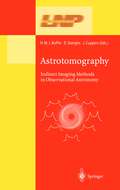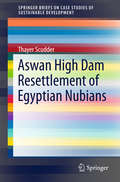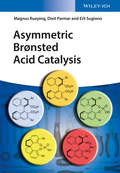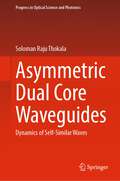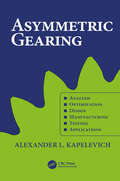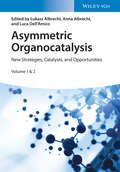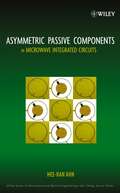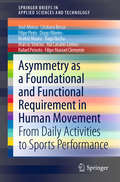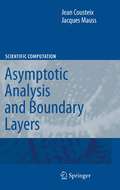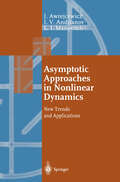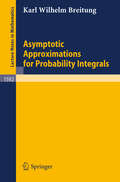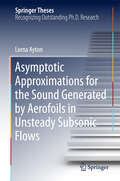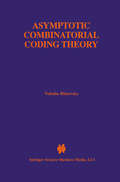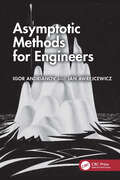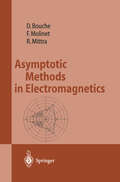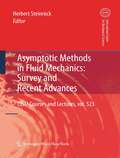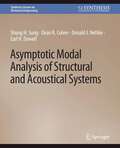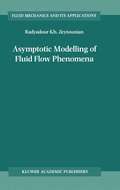- Table View
- List View
Astrophysical Techniques
by C.R. KitchinLong used in undergraduate and introductory graduate courses, Astrophysical Techniques, Seventh Edition provides an accessible yet comprehensive account of the innovate instruments, detectors, and techniques employed in astronomy and astrophysics. Emphasizing the underlying unity of all astronomical observations, this popular textbook provides a coherent state-of-the-art account of the instruments and techniques used in current astronomy and astrophysics. Fully updated throughout, this seventh edition builds upon the sixth edition, covering improved techniques and cutting-edge methods in the field, as well as other exciting new developments in gravitational waves, dark matter and energy, the use of photonics, and astronomy education and outreach, in addition to further detailed discussions on the latest scientific instruments and individual detectors. The book is written in a very accessible manner, and most of the mathematics is accessible to those who have attended a mathematics course in their final years at school. Nevertheless, the treatment of the topics in general is at a sufficiently high level to be of use to those professionals seeking technical information in areas of astronomy with which they might not be completely familiar. Key Features: Details the instrumentation and theory of astronomical observations, including radio waves, gamma rays, cosmic rays, neutrinos, gravitational waves and dark matter and energy and more Presents the background theory and operating practice of state-of-the-art detectors and instruments Fully updated to contain the latest technology and research developments
Astrophysics, Clocks and Fundamental Constants (Lecture Notes in Physics #648)
by Savely G. Karshenboim Ekkehard PeikThe question of a possible temporal variation of the fundamental constants was raised by Paul Dirac in his "large number hypothesis" in 1937. Today it appears in the context of the search for a unified theory of the fundamental interactions. It touches both fundamental and applied physics, as the postulate of the unalterability of the constants is the foundation for modern metrology. The book presents reviews written by leading experts in the field. Focussing on the question of variations of the fundamental "constants" in time or space, the chapters cover the theoretical framework in which variations are expected and the search for variations of quantities like the fine-structure constant, the electron/proton mass ratio, g-factors of proton and neutron etc. in astrophysical and geophysical observations and in precision experiments with atomic clocks and frequency standards.
Astrophysics of the Interstellar Medium (UNITEXT for Physics)
by Giovanni CarraroThis book is based on a series of lectures for an Astrophysics of the Interstellar Medium (ISM) master’s degree in Astrophysics and Cosmology at Padova University. From the cold molecular phase in which stars and planetary systems form, to the very hot coronal gas that surrounds galaxies and galaxy clusters, the ISM is everywhere. Studying its properties is vital for the exploration of virtually any field in astronomy and cosmology. These notes give the student a coherent and accurate mathematical and physical approach, with continuous references to the real ISM in galaxies. The book is divided into three parts. Part One introduces the equations of fluid dynamics for a system at rest and acoustic waves, and then explores the real ISM through the role of thermal conduction and viscosity, concluding with a discussion of shock waves and turbulence. In Part Two, the electromagnetic field is switched on and its role in modulating shock waves and contrasting gravity is studied. Part Three describes dust and its properties, followed by the main stellar sources of energy. The last two chapters respectively address the various components of the ISM and molecular clouds and star formation.
Astrotomography: Indirect Imaging Methods in Observational Astronomy (Lecture Notes in Physics #573)
by H. M. J. Boffin D. Steeghs J. CuypersAswan High Dam Resettlement of Egyptian Nubians (SpringerBriefs on Case Studies of Sustainable Development)
by Thayer ScudderThis book highlights the long-term resettlement process of the Egyptian Nubian people along the Aswan High Dam. Assessing the resettlement of 48,000 Egyptian Nubians in connection with the High Dam is especially important for three main reasons: firstly, this resettlement process is one of the rare cases in which research begun before the dam was built has continued for over forty years. Secondly, the resettlement of the Egyptian Nubian people is one of the few cases in which the living standards of the large majority improved because of the initial political will of the government, combined with Nubian initiatives. Thirdly, given the complexity of the resettlement process, weaknesses in government planning, implementation, and in the weakening of government political provide valuable lessons for future dam-induced resettlement efforts.
Asymmetric Bronsted Acid Catalysis
by Magnus Rueping Dixit Parmar Erli SugionoA much-needed overview of the synthesis of chiral Brønsted acids and their applications in various organic transformations. The internationally recognized and highly respected expert authors summarize the most significant advances in this new and dynamically progressing field, with a special emphasis on BINOL-derived phosphoric acids. They also describe other catalysts, such as C-H, TADDOL-derived Brønsted, and sulfonic acids. For easy navigation, the chapters are organized in the first instance according to reactive intermediate and then sub-divided by reaction type.An appendix with selected experimental details for benign and straight-forward procedures rounds of the book, making this the number-one information source for organic chemists in academia and industry.
Asymmetric Bronsted Acid Catalysis
by Magnus Rueping Dixit Parmar Erli SugionoA much-needed overview of the synthesis of chiral Brønsted acids and their applications in various organic transformations. The internationally recognized and highly respected expert authors summarize the most significant advances in this new and dynamically progressing field, with a special emphasis on BINOL-derived phosphoric acids. They also describe other catalysts, such as C-H, TADDOL-derived Brønsted, and sulfonic acids. For easy navigation, the chapters are organized in the first instance according to reactive intermediate and then sub-divided by reaction type.An appendix with selected experimental details for benign and straight-forward procedures rounds of the book, making this the number-one information source for organic chemists in academia and industry.
Asymmetric Dual Core Waveguides: Dynamics of Self-Similar Waves (Progress in Optical Science and Photonics #22)
by Soloman Raju ThokalaThis book highlights the dynamical behavior of self-similar waves in asymmetric dual-core waveguides. The proposed dual-core waveguide consists of two closely spaced adjoining fibers in which one fiber is active and the other is passive. Due to the linear coupling between them, the dynamics of the wave propagating through the passive core can be controlled by manipulating the dynamics of the wave propagating in the active core. The optimal pulse compression or amplification of these waves as the length of the fiber tends to infinity is presented. The exact Mobius transform self-similar solutions that propagate through these waveguides self-similarly are subject to simple scaling rules. The book includes experiments conducted to corroborate the analytical predictions.
Asymmetric Gearing
by Alexander L. KapelevichThe history of gears with asymmetric teeth is not sufficiently recorded in modern gear literature, with some gear researchers concluding that asymmetric tooth gears were discovered just several decades ago. This book sheds light upon the origins and state of asymmetric gearing, referencing technical articles from the 19th, 20th, and 21st centuries. As a practicing gear engineer with over 40 years’ experience, author Alexander L. Kapelevich has successfully implemented asymmetric gears in a variety of custom gear transmissions. This book addresses all aspects of asymmetric gear development, including theoretical fundamentals; tooth geometry optimization; stress analysis and rating; design and production specifics; analytical and experimental comparison to the best symmetric gears; and application examples. Readers are encouraged to look beyond the status quo established by traditional gear design, and to apply principles of asymmetric gearing to actual gear design. Optimal solutions are presented for gear drives that will maximize technical performance and marketability. Features Presents a state-of the-art, comprehensive historical overview of asymmetric gearing Explains the Direct Gear Design® approach to asymmetric gear design Describes asymmetric tooth gear geometry optimization, areas of existence, and parameter selection limits Considers practical aspects of asymmetric gear fabrication and measurement Presents analytical and experimental comparison of asymmetric gears to advanced symmetric gears, showing the advantages of asymmetric designs Provides numerous real-world examples of asymmetric gear application
Asymmetric Gearing
by Alexander L. KapelevichThe history of gears with asymmetric teeth is not sufficiently recorded in modern gear literature, with some gear researchers concluding that asymmetric tooth gears were discovered just several decades ago. This book sheds light upon the origins and state of asymmetric gearing, referencing technical articles from the 19th, 20th, and 21st centuries. As a practicing gear engineer with over 40 years’ experience, author Alexander L. Kapelevich has successfully implemented asymmetric gears in a variety of custom gear transmissions. This book addresses all aspects of asymmetric gear development, including theoretical fundamentals; tooth geometry optimization; stress analysis and rating; design and production specifics; analytical and experimental comparison to the best symmetric gears; and application examples. Readers are encouraged to look beyond the status quo established by traditional gear design, and to apply principles of asymmetric gearing to actual gear design. Optimal solutions are presented for gear drives that will maximize technical performance and marketability. Features Presents a state-of the-art, comprehensive historical overview of asymmetric gearing Explains the Direct Gear Design® approach to asymmetric gear design Describes asymmetric tooth gear geometry optimization, areas of existence, and parameter selection limits Considers practical aspects of asymmetric gear fabrication and measurement Presents analytical and experimental comparison of asymmetric gears to advanced symmetric gears, showing the advantages of asymmetric designs Provides numerous real-world examples of asymmetric gear application
Asymmetric Organocatalysis: New Strategies, Catalysts, and Opportunities, 2 Volumes
by Lukasz AlbrechtAsymmetric Organocatalysis Comprehensive resource on the latest and most important developments in the highly vivid field of asymmetric organocatalysis The book provides a comprehensive overview of the most important advancements in the field of asymmetric organocatalysis that have occurred within the last decade. It presents valuable examples of newly developed synthetic methodologies based on various organocatalytic activation modes. Special emphasis is given to strategies where organocatalysis is expanding its potential by pushing the boundaries and founding new synergistic interactions with other fields of synthetic chemistry, such as metal catalysis, photocatalysis, and biocatalysis. The application of different concepts (such as vinylogy, dearomatization, or cascade reactivity), resulting in the development of new functionalization strategies, is also discussed. Sample topics covered within the book include: New developments in enantioselective Brønsted acid catalysis with strong hydrogen-bond donors Asymmetric phase-transfer catalysis, from classical applications to new concepts Halogen-bonding organocatalysis Asymmetric electrochemical organocatalysis and synergistic organo-organocatalysis Immobilized organocatalysts for enantioselective continuous flow processes Mechanochemistry and high-pressure techniques in asymmetric organocatalysis Useful tools in elucidation of organocatalytic reaction mechanisms With an overall focus on new reactions and catalysts, this two-volume work is an indispensable source for everyone working in the field of asymmetric organocatalysis.
Asymmetric Organocatalysis: New Strategies, Catalysts, and Opportunities, 2 Volumes
by Lukasz Albrecht Anna Albrecht Luca Dell'AmicoAsymmetric Organocatalysis Comprehensive resource on the latest and most important developments in the highly vivid field of asymmetric organocatalysis The book provides a comprehensive overview of the most important advancements in the field of asymmetric organocatalysis that have occurred within the last decade. It presents valuable examples of newly developed synthetic methodologies based on various organocatalytic activation modes. Special emphasis is given to strategies where organocatalysis is expanding its potential by pushing the boundaries and founding new synergistic interactions with other fields of synthetic chemistry, such as metal catalysis, photocatalysis, and biocatalysis. The application of different concepts (such as vinylogy, dearomatization, or cascade reactivity), resulting in the development of new functionalization strategies, is also discussed. Sample topics covered within the book include: New developments in enantioselective Brønsted acid catalysis with strong hydrogen-bond donors Asymmetric phase-transfer catalysis, from classical applications to new concepts Halogen-bonding organocatalysis Asymmetric electrochemical organocatalysis and synergistic organo-organocatalysis Immobilized organocatalysts for enantioselective continuous flow processes Mechanochemistry and high-pressure techniques in asymmetric organocatalysis Useful tools in elucidation of organocatalytic reaction mechanisms With an overall focus on new reactions and catalysts, this two-volume work is an indispensable source for everyone working in the field of asymmetric organocatalysis.
Asymmetric Passive Components in Microwave Integrated Circuits (Wiley Series in Microwave and Optical Engineering #182)
by Hee-Ran AhnThis book examines the new and important technology of asymmetric passive components for miniaturized microwave passive circuits. The asymmetric design methods and ideas set forth by the author are groundbreaking and have not been treated in previous works. Readers discover how these design methods reduce the circuit size of microwave integrated circuits and are also critical to reducing the cost of equipment such as cellular phones, radars, antennas, automobiles, and robots. An introductory chapter on the history of asymmetric passive components, which began with asymmetric ring hybrids first described by the author, sets the background for the book. It lays a solid foundation with a chapter examining microwave circuit parameters such as scattering, ABCD, impedance, admittance, and image. A valuable feature of this chapter is a conversion table between the various circuit matrices characterizing two-port networks terminated in arbitrary impedances. The correct conversion has also never been treated in previous works. Next, the author sets forth a thorough treatment of asymmetric passive component design, which covers the basic and indispensable elements for integration with other active or passive devices, including: * Asymmetric ring hybrids * Asymmetric branch-line hybrids * Asymmetric three-port power dividers and N-way power dividers * Asymmetric ring hybrid phase shifters and attenuators * Asymmetric ring filters and asymmetric impedance transformers With its focus on the principles of circuit element design, this is a must-have graduate-level textbook for students in microwave engineering, as well as a reference for design engineers who want to learn the new and powerful design method for asymmetric passive components.
Asymmetry as a Foundational and Functional Requirement in Human Movement: From Daily Activities to Sports Performance (SpringerBriefs in Applied Sciences and Technology)
by José Afonso Cristiana Bessa Filipe Pinto Diogo Ribeiro Beatriz Moura Tiago Rocha Marcus Vinícius Rui Canário-Lemos Rafael Peixoto Filipe Manuel ClementeThis book describes the structural and functional asymmetries in human body movement by providing cases and examples using illustrations and easy-to-understand scenarios. Specifically, it adopts an evidence-based approach to demonstrate (i) the role of structural (e.g., bone dimensions) and functional (e.g., hemispheric dominance) asymmetries in the human body; (ii) the asymmetric nature of most daily activities (e.g., gait, mastication); (iii) the benefits of asymmetry for physical performance; and (iv) the role of asymmetry in preventing injury. More than just a scientific book, it bridges the gap between theory and practice, and includes practical examples and applications. The book appeals to academics and practitioners in the fields of kinesiology, human movement, sports sciences, strength and conditioning, and physiotherapy.
Asymptotic Analysis and Boundary Layers (Scientific Computation)
by Jean Cousteix Jacques MaussThis book presents a new method of asymptotic analysis of boundary-layer problems, the Successive Complementary Expansion Method (SCEM). The first part is devoted to a general presentation of the tools of asymptotic analysis. It gives the keys to understand a boundary-layer problem and explains the methods to construct an approximation. The second part is devoted to SCEM and its applications in fluid mechanics, including external and internal flows.
Asymptotic Approaches in Nonlinear Dynamics: New Trends and Applications (Springer Series in Synergetics #69)
by Jan Awrejcewicz Igor V. Andrianov Leonid I. ManevitchThis book covers developments in the theory of oscillations from diverse viewpoints, reflecting the fields multidisciplinary nature. It introduces the state-of-the-art in the theory and various applications of nonlinear dynamics. It also offers the first treatment of the asymptotic and homogenization methods in the theory of oscillations in combination with Pad approximations. With its wealth of interesting examples, this book will prove useful as an introduction to the field for novices and as a reference for specialists.
Asymptotic Approximations for Probability Integrals (Lecture Notes in Mathematics #1592)
by Karl W. BreitungThis book gives a self-contained introduction to the subject of asymptotic approximation for multivariate integrals for both mathematicians and applied scientists. A collection of results of the Laplace methods is given. Such methods are useful for example in reliability, statistics, theoretical physics and information theory. An important special case is the approximation of multidimensional normal integrals. Here the relation between the differential geometry of the boundary of the integration domain and the asymptotic probability content is derived. One of the most important applications of these methods is in structural reliability. Engineers working in this field will find here a complete outline of asymptotic approximation methods for failure probability integrals.
Asymptotic Approximations for the Sound Generated by Aerofoils in Unsteady Subsonic Flows (Springer Theses)
by Lorna AytonThis thesis investigates the sound generated by solid bodies in steady subsonic flows with unsteady perturbations, as is typically used when determining the noise generated by turbulent interactions. The focus is predominantly on modelling the sound generated by blades within an aircraft engine, and the solutions are presented as asymptotic approximations. Key analytical techniques, such as the Wiener-Hopf method, and the matched asymptotic expansion method are clearly detailed. The results allow for the effect of variations in the steady flow or blade shape on the noise generated to be analysed much faster than when solving the problem numerically or considering it experimentally.
Asymptotic Combinatorial Coding Theory (The Springer International Series in Engineering and Computer Science #415)
by Volodia BlinovskyAsymptotic Combinatorial Coding Theory is devoted to the investigation of the combinatorial properties of transmission systems using discrete signals. The book presents results of interest to specialists in combinatorics seeking to apply combinatorial methods to problems of combinatorial coding theory. Asymptotic Combinatorial Coding Theory serves as an excellent reference for resarchers in discrete mathematics, combinatorics, and combinatorial coding theory, and may be used as a text for advanced courses on the subject.
Asymptotic Methods for Engineers
by Igor V. Andrianov Jan AwrejcewiczAsymptotic Methods for Engineers is based on the authors’ many years of practical experience in the application of asymptotic methods to solve engineering problems.This book is devoted to modern asymptotic methods (AM), which is widely used in engineering, applied sciences, physics, and applied mathematics. Avoiding complex formal calculations and justifications, the book’s main goal is to describe the main ideas and algorithms. Moreover, not only is there a presentation of the main AM, but there is also a focus on demonstrating their unity and inseparable connection with the methods of summation and asymptotic interpolation.The book will be useful for students and researchers from applied mathematics and physics and of interest to doctoral and graduate students, university and industry professors from various branches of engineering (mechanical, civil, electro-mechanical, etc.).
Asymptotic Methods for Engineers
by Igor V. Andrianov Jan AwrejcewiczAsymptotic Methods for Engineers is based on the authors’ many years of practical experience in the application of asymptotic methods to solve engineering problems.This book is devoted to modern asymptotic methods (AM), which is widely used in engineering, applied sciences, physics, and applied mathematics. Avoiding complex formal calculations and justifications, the book’s main goal is to describe the main ideas and algorithms. Moreover, not only is there a presentation of the main AM, but there is also a focus on demonstrating their unity and inseparable connection with the methods of summation and asymptotic interpolation.The book will be useful for students and researchers from applied mathematics and physics and of interest to doctoral and graduate students, university and industry professors from various branches of engineering (mechanical, civil, electro-mechanical, etc.).
Asymptotic Methods in Electromagnetics
by Daniel Bouche Frederic Molinet Raj MittraNumerically rigorous techniques for the computation of electromagnetic fields diffracted by an object become computationally intensive, if not impractical to handle, at high frequencies and one must resort to asymptotic methods to solve the scattering problem at short wavelengths. The asymptotic methods provide closed form expansions for the diffracted fields and are also useful for eliciting physical interpretations of the various diffraction phenomena. One of the principal objectives of this book is to discuss the different asymptotic methods in a unified manner. Although the book contains explicit formulas for computing the field diffracted by conducting or dielectric-coated objects, it also provides the mathematical foundations of the different methods and explains how they are interrelated.
Asymptotic Methods in Fluid Mechanics: Survey and Recent Advances (CISM International Centre for Mechanical Sciences #523)
by Herbert SteinrückA survey of asymptotic methods in fluid mechanics and applications is given including high Reynolds number flows (interacting boundary layers, marginal separation, turbulence asymptotics) and low Reynolds number flows as an example of hybrid methods, waves as an example of exponential asymptotics and multiple scales methods in meteorology.
Asymptotic Modal Analysis of Structural and Acoustical Systems (Synthesis Lectures on Mechanical Engineering)
by Shung Sung Dean Culver Donald Nefske Earl DowellThis book describes the Asymptotic Modal Analysis (AMA) method to predict the high-frequency vibroacoustic response of structural and acoustical systems. The AMA method is based on taking the asymptotic limit of Classical Modal Analysis (CMA) as the number of modes in the structural system or acoustical system becomes large in a certain frequency bandwidth. While CMA requires both the computation of individual modes and a modal summation, AMA evaluates the averaged modal response only at a center frequency of the bandwidth and does not sum the individual contributions from each mode to obtain a final result. It is similar to Statistical Energy Analysis (SEA) in this respect. However, while SEA is limited to obtaining spatial averages or mean values (as it is a statistical method), AMA is derived systematically from CMA and can provide spatial information as well as estimates of the accuracy of the solution for a particular number of modes. A principal goal is to present the state-of-the-art of AMA and suggest where further developments may be possible. A short review of the CMA method as applied to structural and acoustical systems subjected to random excitation is first presented. Then the development of AMA is presented for an individual structural system and an individual acoustic cavity system, as well as a combined structural-acoustic system. The extension of AMA for treating coupled or multi-component systems is then described, followed by its application to nonlinear systems. Finally, the AMA method is summarized and potential further developments are discussed.
Asymptotic Modelling of Fluid Flow Phenomena (Fluid Mechanics and Its Applications #64)
by Radyadour Kh. Zeytounianfor the fluctuations around the means but rather fluctuations, and appearing in the following incompressible system of equations: on any wall; at initial time, and are assumed known. This contribution arose from discussion with J. P. Guiraud on attempts to push forward our last co-signed paper (1986) and the main idea is to put a stochastic structure on fluctuations and to identify the large eddies with a part of the probability space. The Reynolds stresses are derived from a kind of Monte-Carlo process on equations for fluctuations. Those are themselves modelled against a technique, using the Guiraud and Zeytounian (1986). The scheme consists in a set of like equations, considered as random, because they mimic the large eddy fluctuations. The Reynolds stresses are got from stochastic averaging over a family of their solutions. Asymptotics underlies the scheme, but in a rather loose hidden way. We explain this in relation with homogenizati- localization processes (described within the §3. 4 ofChapter 3). Ofcourse the mathematical well posedness of the scheme is not known and the numerics would be formidable! Whether this attempt will inspire researchers in the field of highly complex turbulent flows is not foreseeable and we have hope that the idea will prove useful.



